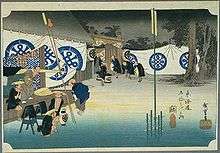Seki-juku (Tōkaidō)
Seki-juku (関宿, Seki-juku) was the forty-seventh of the fifty-three stations of the Tōkaidō. It is located in former Ise Province in what is now part of the city of Kameyama, Mie Prefecture, Japan.[1]

History

The area around Seki-juku was always a major intersection for travel. During the time of the Jinshin War, it was known as one of the Three Ancient Seki, being called the Ise Suzuka Seki (伊勢鈴鹿の関, Ise Suzuka Barrier), and was an administrative checkpoint on the highway to the eastern provinces.
During the Edo period, the area flourished as a lively post town, because both the Isebetsu Kaidō (伊勢別街道), a highway for pilgrims to the Ise Grand Shrines and the Yamato Kaidō (大和街道), a highway for travelers to Yamato Province, intersected here with the Tōkaidō highway. Following the Meiji Restoration, Seki-juku became the nucleus for the modern town of Seki, which became part of the city of Kameyama in 2005.
The classic ukiyo-e print by Andō Hiroshige (Hōeido edition) from 1831–1834 depicts the retinue of a daimyō on sankin-kōtai preparing to leave an upper-class inn during the early hours of the morning.

Many of the historical buildings have been preserved and the area has been designated as Important Preservation District for Groups of Traditional Buildings.[1]
Neighboring post towns
- Tōkaidō
- Kameyama-juku - Seki-juku - Sakashita-juku
References
- Mie Tourism Guide: Ancient Tokaido Seki-juku. Mie Prefecture. Accessed November 29, 2007.
See also
Further reading
| Wikimedia Commons has media related to Seki-juku. |
- Carey, Patrick. Rediscovering the Old Tokaido:In the Footsteps of Hiroshige. Global Books UK (2000). ISBN 1-901903-10-9
- Chiba, Reiko. Hiroshige's Tokaido in Prints and Poetry. Tuttle. (1982) ISBN 0-8048-0246-7
- Taganau, Jilly. The Tokaido Road: Travelling and Representation in Edo and Meiji Japan. RoutledgeCurzon (2004). ISBN 0-415-31091-1